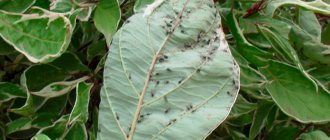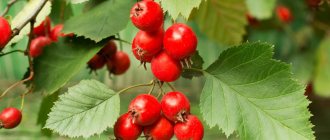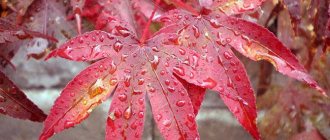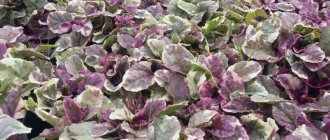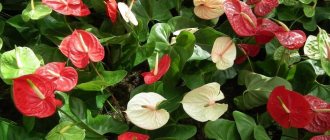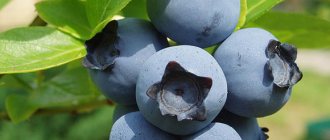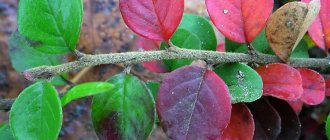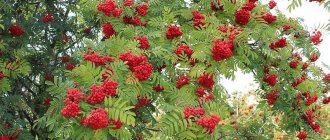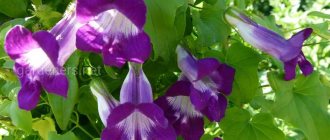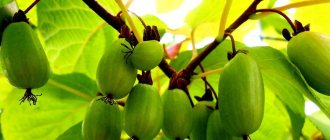Today you can rarely see hawthorn in summer cottages, so let’s start getting acquainted with it with a description of the blood-red hawthorn. And many of you probably know that the fruits of hawthorn have great healing powers, and the plant itself looks very attractive in a summer cottage.
Usually in spring or early summer, depending on the species, hawthorn is covered with pale pink or white inflorescences. It is also good in the fall, when the leaves are colored yellow, orange or purple, and against their background the red fruits collected in clusters stand out brightly. Hawthorn does not lose its attractiveness even after leaf fall, in winter, thanks to the red coloring of the branches and bright berries that do not fall off for a long time.
Blood red or Siberian hawthorn
This variety grows wild in the taiga zones of Siberia and the Far East. Most often this species can be seen along the edges, in very wet riverine areas. Prefers permeable and deeply moist soils. The species has been grown in garden culture since 1822.
When growing Siberian hawthorn on a personal plot, it is formed into a compact bush or an elegant tree up to 5-6 meters high. The spines of this variety are very rare, but quite long - up to 5 cm. The foliage is very dark, rich green on the upper side and very light underneath. Leaf length is up to 10 cm. Siberian or blood-red hawthorn is noticeably different from other varieties with brown bark and very shiny, almost purple-brown long branches. The inflorescence scutes of the variety reach a diameter of 5 cm and consist of snow-white, fairly large flowers with very bright, purple anthers. This species begins to bloom at the end of May, and continues its flowering until the end of June. The berries of this variety are blood red, which is why the tree got its name. The fruits and berries contain three or four seeds and edible, very tasty mealy pulp. The ripening of berries begins at the end of the summer.
This variety is frost-resistant and absolutely unpretentious. Experienced gardeners successfully grow and form almost impenetrable hedges from this variety and plant them in small groups.
If you grow this variety from seeds, it will begin to bear fruit only in the 7th year of life. It is noteworthy that Michurin used the pollen of this plant species to pollinate ordinary rowan, and as a result, a variety of rowan pomegranate was obtained with sweet, completely without bitterness, tasty berries.
Reproduction
To plant a small amount of blood-red hawthorn on a personal plot, it is advisable to purchase seedlings in a specialized store or garden center.
Attention! If you grow blood-red hawthorn yourself, you will have to wait about 8 years for flowering and fruiting.
There is nothing difficult about propagating blood-red hawthorn. It is best to use vegetative methods, for example, rooting cuttings. The lower branches of the mother plant are fixed to the soil and dug in. With regular watering, they quickly take root, and next year the young seedlings can be planted.
Blood-red hawthorn is also propagated by root cuttings: roots of medium thickness are cut into pieces approximately 10 cm long and placed in the ground under film or glass.
You can graft blood-red hawthorn onto trees of other varieties of hawthorn, for example, prickly or common.
The most time-consuming and labor-intensive way to obtain young blood-red hawthorn plants is to grow from seeds. Seed material must be stratified.
Attention! The germination rate of blood-red hawthorn seeds is quite low: only in half of the cases can sprouts appear.
For sowing, seeds of blood-red hawthorn fruits that have not reached full maturity are taken, prepared and sown in boxes before winter. Seedlings of the first year of life require constant care; starting from the second year they are grown in the beds.
Common or prickly hawthorn
This variety is very beautiful during flowering. It is a tree or shrub, sometimes reaching a height of 3-4 meters. The crown of the variety is very dense, with numerous sharp spines, although cultivated forms may lack spines. The leaves of prickly hawthorn are up to 4 cm long, white flowers are collected in corymbs-inflorescences. This species begins to bloom in May. The fruits of prickly hawthorn are too small, round, red, with high taste, and begin to ripen by September. In the wild, this variety grows in Transcarpathia, the Kaliningrad region, Scandinavia, and Western Europe. In small garden plots, a smooth form of prickly hawthorn, reaching a height of 3 meters, is often grown. The plant is winter-hardy and grows well in the middle and southern regions. It is quite shade-tolerant, very drought-resistant, and is not at all picky about soil - it can grow even on rocky soil.
Preparation of medicinal preparations from hawthorn flowers at home
Our pharmacies usually sell tinctures of hawthorn flowers or fruits. But it is not difficult to prepare medicinal preparations from hawthorn at home.
Hawthorn flowers are collected in late May-early June, when some of the flowers are still in buds. They must be dry, since even slightly damp flowers darken when dried and, most importantly, lose their healing properties. Hawthorn flowers are cleared of twigs and dried outdoors in the shade or in a ventilated room, scattered in a thin layer on a clean litter.
To prepare a flower infusion from hawthorn, 1 tbsp. pour 200 ml of boiling water over a spoonful of dried flowers, leave for 1 hour, filter and drink ½ cup 3-4 times a day.
Hawthorn flower tincture takes longer to prepare, but it can also be taken as a sedative. Take 10 g of dried flowers and pour 100 ml of high-quality vodka. Insist for two weeks in a place protected from light. Strain and take 20-25 drops per 30 ml of water 3 times a day or 40-50 drops as a sedative.
Hawthorn pinnately cut
This variety has been grown in garden culture since the 19th century. It grows mainly in damp river valleys, and is found in the lower parts of mountain ranges in the Amur and Primorye regions. This variety of hawthorn can also be found in China and Korea. Very often, pinnathorn hawthorn grows in the undergrowth of oak trees and in thickets of various shrubs.
Cirrus hawthorn is a tree up to 6 meters high or a shrub. The pink flowers of the tree are collected in drooping corymbs. The crown of the tree is thick and spreading, the bark is dark gray. This variety of hawthorn has no thorns or very few of them. You can recognize the variety by its beautiful bright green leaves, which are quite large. The fruits of the pinnathorn hawthorn are bright red in color, dotted with small white warts. The variety blooms in June, the fruits ripen by September. The tree begins to bear fruit at the age of six.
The plant is light-loving and loves moist, nutritious soil. The species is very resistant to significant drops in air temperature, which allows it to be grown in culture almost everywhere.
Plants of this variety tolerate replanting well, can be pruned, and can grow and develop in polluted city conditions. Seed germination is very low - only 10%, so hawthorn is propagated by pinnate cuttings or root suckers. The tree is very decorative throughout the season and is widely used in the design of gardens and parks. This variety is considered the most decorative.
Hawthorn single-stone or single-pistillate
This species grows in Russia and in the Caucasus region, in some regions of Asia. This variety has been grown in garden culture since 1880. According to its characteristics, the variety is close to the prickly species, but differs from it in faster growth, large pink flowers and unpretentiousness. The hawthorn unicorn lives for about 2-3 centuries. Hawthorn of this variety is a tree 3-6 meters in height, although in favorable conditions the tree can reach 12 meters in height. The shoots of the tree are bare, the old branches acquire a brownish-gray tint. This variety has very few spines, and they are up to 1 cm in length. Single-stone hawthorn inflorescences consist of 10-18 flowers. The fruits are round, up to 1 cm in diameter, with only one seed. The tree begins to bear fruit from the age of 6 years. Many decorative forms were selected for cultivation of this variety. There are species that bloom throughout the summer, with double flowers in rich red or white.
Recommendations for choosing a location and planting
Hawthorn, as a long-liver, must definitely choose a suitable place, given that the plant is light-loving, although it can grow in partial shade. It is better to plant it on the north side of the site. Hawthorn can be planted in early spring and in autumn before frost.
If you are lucky and see hawthorn for sale, choose 2-3 year old seedlings.
When planting several hawthorn bushes, planting holes (40-60 cm deep, 50-60 cm wide) are dug every 2 m. For a hawthorn hedge, a trench is dug. A layer of soil removed from above is placed on the bottom (it is the most fertile), fertilizers are applied: 100-150 g of superphosphate and 50-70 g of potassium salt per hole and twice as much per linear meter of trench.
Add compost or humus at the rate of 1-1.5 buckets per planting hole or 2-3 buckets per 1 linear meter of trench. For acidic soil, be sure to add up to 1 kg of lime to the planting hole. Everything is mixed.
They make a mound of earth, sprinkle it with fertile soil without fertilizers, and place a hawthorn seedling on it. Then water at the rate of 1 bucket per 1 plant or 2 buckets per linear meter of trench. After watering, it is advisable to sprinkle the soil around the hawthorn seedling with humus or peat.
"Cock's spur" or spur hawthorn
This species is found very often in the wild in the northern part of the United States. It grows mainly in deeply moist river valleys, on steep slopes, and along forest edges. This species has been grown in garden culture for a very long time - since 1656.
Hawthorn is a very spreading shrub or tree, sometimes reaching a height of 12 meters. This variety is the tallest among all hawthorn varieties. The crown of the tree is wide, with drooping branches, with numerous long (up to 10 cm) spines that resemble the spur of a rooster. The leaves of this variety are leathery, bare, elongated, up to 10 cm, and acquire a purple tint in autumn. The flowers of hawthorn are large, up to 2 cm, collected in corymbs. In spring, the tree is very decorative - large flowers cover the crown. In summer, the spur hawthorn is also beautiful - its luscious foliage attracts attention, and in autumn the tree looks impressive due to the bright color of the leaves. The fruits of the hawthorn can range in color from faint greenish to dull red. The berries ripen in September and stay on the tree almost all winter. This variety grows very quickly, tolerates drought well, and grows even in a polluted city. The tree does not tolerate pruning very well. This variety is often used to create living, almost impenetrable hedges.
Preparation of infusions and decoctions from fruits
The healing properties of hawthorn flowers are high, but there is one drawback - an unpleasant odor. Therefore, it is better for people with a particularly sensitive sense of smell to use the equally healing fruits of hawthorn. They are collected in September and early October. Dry in the oven or a special dryer at 50-60 degrees.
Well-dried fruits have a pleasant color and smell. They are poured into thick paper bags, tin or cardboard boxes and stored in a cool, dry place. When properly stored, hawthorn fruits retain their healing properties for up to 8 years.
To prepare an infusion of hawthorn fruits, grind them in a coffee grinder, 2 tbsp. spoons are poured with 400 ml of boiling water, covered with a cotton doll and left for an hour, filtered and taken ½ cup 3-4 times a day.
A decoction of hawthorn fruits is prepared as follows: 50 g of crushed dry fruits are poured into 500 ml of water and boiled in a water bath for 15 minutes. After an hour, filter. Take ½ glass 3-4 times a day.
A tincture is prepared from hawthorn fruits. Pour 20 g of dry crushed fruits with 200 ml of vodka and leave for two weeks in a place protected from light. Strain and take 30-40 drops per 30 ml of water 3 times a day.
Green meat hawthorn
This variety often grows in the form of a spreading shrub, much less often in the form of an elegant, small tree. The variety can reach 4-6 meters in height. On the old branches of the tree and on the trunk, the bark has a grayish color. Young shoots are dark purple, the spines of the tree reach a length of 1.5 cm. The leaves are slightly pubescent on top, very densely pubescent below. The variety blooms with snow-white flowers, which are collected in corymbs. Dark, almost black anthers of the stamens stand out against the background of the snow-white petals of the flowers. The fruits of trees of this variety are very interesting - spherical, black in color, with greenish flesh, very good taste. The variety blooms profusely, has a densely leafy crown, brightly colored leaves, which looks very decorative. Green hawthorn is very often used in landscaping parks and private plots, and hedges are created from it. The variety is unpretentious.
Hawthorn softish
The main advantage of this species is its large fruits, with juicy, mealy pulp, and very tasty. This species is a representative of the typical American flora. In the wild, it prefers moist soil on slopes and forest edges of the northern United States and Canada.
This species is a tree sometimes reaching 8 meters in height. The crown is dense, tent-shaped. Young shoots are lush green in color, while old shoots are ash-gray. The tree has many spines up to 8 cm long. The young foliage of the species is heavily pubescent. In autumn the leaves take on a reddish-brown hue. Large flowers of the species are collected in inflorescences-corymbs of 10-15 pieces. This species begins to bear fruit from the age of six. The species is very decorative throughout the season - its dense crown and fairly large flowers make it a desirable inhabitant of any garden or park. The crown lends itself well to shaping and this variety is perfect for forming living fences.
Hawthorn macroanther
Under natural conditions, this species grows in the northern part of the United States. It lives on slopes with rich, nutritious soil, which contains a lot of lime. It is also found in the Baltic countries, Ukraine, and the European zone of Russia.
This species is simply irreplaceable for the formation of truly impenetrable living fences, as it has very sharp and strong spines, sometimes up to 12 cm long. The species is a tree up to 5 meters in height with a very dense crown. The bark of old branches and trunk has a grayish tint, the shoots are chestnut in color. The foliage is dark green, juicy, shiny, slightly pubescent on the lower part. In autumn, the leaves turn reddish, purple and yellow, which looks very decorative. The variety blooms with snow-white flowers up to 2 cm in diameter, which are collected in corymbs. Flowering begins at the end of May and continues until the beginning of June. The variety is high-yielding and produces a lot of bright red berries with dark yellow, very tasty pulp. The foliage stays on the trees for a very long time and against its background the red fruits look very impressive. It prefers sunlit areas in cultivation, although it can also tolerate light partial shade.
This variety is simply irreplaceable for the formation of living fences; it looks very decorative during flowering and also during the ripening period of berries.
Diseases and pests
Although this crop is unpretentious, pest and disease control is one of the mandatory care procedures.
Plantings can be affected by apple aphids and scale insects, which damage the leaves and young branches of the plant. Aktara and Karbofos help cope with these pests.
Blood red hawthorn is also susceptible to fungal diseases. Rust and yellow spotting are common. Both diseases lead to the appearance of spots on the leaves, then the foliage falls off. Treating bushes with copper sulfate can help in the fight against these and other fungal diseases. They also carry out preventive spraying of blood-red hawthorn at the beginning and end of the season. It is very important to promptly remove plant debris, which can harbor pathogens even in winter.
Powdery mildew is another common disease of fruit trees, including blood-red hawthorn. A white or gray coating resembling a cobweb forms on parts of the plant. Leaves and young shoots become deformed and soon dry out. All affected parts should be destroyed, and the bush should be treated with a fungicide several times.
Attention! A well-groomed plant is rarely affected by diseases and pests.
Hawthorn pontica
This species grows in Asian regions and the Caucasus. Shrubs or graceful, thin trees form thickets on slopes and even live on rocky soils. The species grows well along the banks of mountain rivers. Can grow at an altitude of 2000 meters in the mountains. It is characterized by increased drought resistance. This species has a very developed root system, and therefore it is often used for landscaping and strengthening slopes. The variety grows very slowly, life expectancy is up to two centuries. The tree grows up to 5 meters in height. The variety is light-loving and tolerates heat and drought very well. Pontian hawthorn is very decorative - its spreading crown, bluish-green, beautiful, succulent leaves, large white flowers attract a lot of attention. The fruits are quite large, very tasty, fleshy, yellow in color.
Riverside hawthorn
This species is a small graceful tree or shrub, reaching a height of up to 6 meters. In nature it grows in North America on slopes. In Russia this species is not found often. The species has dark green, succulent leaves, blooms with small flowers up to 1 cm in size. It begins to bloom and bear fruit from the eighth year of life. Seed germination is too low - only 7%. Prefers illuminated areas, as well as well-moistened soils. It is not at all picky about soil composition.
Arnold's hawthorn
Under natural conditions, this variety grows in the northern part of the USA. According to its biological data, it is close to the softish variety. It differs from it only in thicker shoots and more rounded leaves. The berries of this type are bright carmine. The fruits ripen early and fall very quickly. The pulp of the berries tastes sour. The fruits contain three to four seeds. If you grow this variety from seeds, the plant will begin to gain strength only from 4-5 years of age. The first flowering when grown from seeds will be only at 5-6 years of age. With proper care, the tree will reach its maximum height in 25 years. Life expectancy 2-3 centuries. This species overwinters well in our climatic conditions, is not picky about soil composition, and tolerates drought.
These are not all varieties of hawthorn that are grown in cultivation. Be sure to plant this tree on your site, because it is very beautiful and unpretentious, and its fruits are very useful.
Beneficial features
Hawthorn has such strong properties that regulate cardiac activity that it can enhance the contraction of the heart muscle, prevent angina pectoris, arrhythmia, and help treat cardiac neuroses. Not only hawthorn fruits, but also flowers have been recognized by traditional medicine as a cure for diseases of the heart and blood vessels.
Ancient manuscripts have been preserved that tell us that even in Ancient Rus', folk healers treated hawthorn. Our ancestors believed in the mystical power of this plant. It was believed that hawthorn absorbed bad energy, so it was planted as protection from evil and envy.
Hawthorn saved many lives during the Great Patriotic War, when it was used as a substitute for heart medications that were in short supply at that time.
Medicines made from hawthorn improve blood circulation, promote the dilation of blood vessels in the brain, and have a beneficial effect on the rhythm of heart contractions. People suffering from heart disease experience a significant improvement in their general condition. Under their influence, swelling, shortness of breath, pain and a feeling of heaviness in the heart area are reduced.
In addition, they cleanse blood vessels well, increase hemoglobin in the blood, and are also useful for patients with diabetes, although few people know about this. Hawthorn also significantly lowers blood cholesterol levels. For heart neuroses, insomnia and other diseases, a mixture of hawthorn and valerian preparations helps well.
